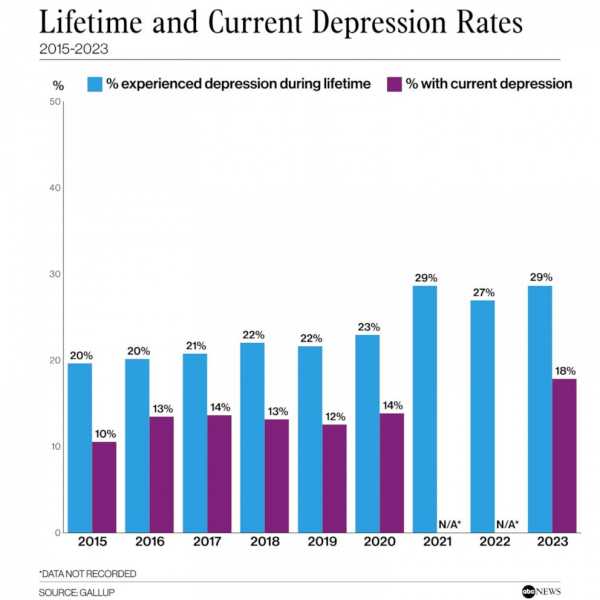Depression rates in the United States are skyrocketing, particularly among young adults and women, a new poll shows.
The survey, published by Gallup on Wednesday, found 29% of U.S. adults report being diagnosed with depression at some point during their lifetimes, an increase from 19.6% in 2015.
Meanwhile, 17.8% of those aged 18 and older either currently have or are currently being treated for depression, up from 10.5% in 2015.
According to Gallup, both rates are the highest ever recorded by the analytics company since it began tracking depression rates.
MORE: Teen girls are experiencing record-high levels of sadness and violence: CDC
"I think the results are startling," Dan Witters, research director of the Gallup National Health and Well-Being, told ABC News. "The disproportionate manner in which some groups have been affected by this makes sense to me based upon what we know about other research and those sharp increases in those depression rates among those adults under 30, women too, Blacks and Hispanics, they are really eye-popping."
Although the COVID-19 pandemic can't be blamed completely for the increasing rates, it definitely was a major factor, Witters said.
"Both of these rates had kind of been coming up over the years pre-pandemic," he said. "And you don't want to get too far out in front of your skis as far as putting all the blame on the pandemic."
He went on, "There's plenty of other big factors out there that could be relevant to these increasing rates that we've been measuring but the pandemic's a big one and indeed the rates have really come up significantly in the years since COVID hit."

Lifetime and Current Depression RatesABC News, Gallup
More than 5,100 adults were surveyed in all 50 states and the District of Columbia during the last week of February 2023. The results are part of the larger ongoing Gallup National Health and Well-Being Index, which seeks to track and understand factors that drive well-being.
Results showed rates are rising fastest among certain groups, particularly young adults and women.
Women's rates of depression during their lifetimes climbed from 26.2% in 2017 to 36.7% in 2023. Rates of those with current depression increased from 17.6% to 23.8% over the same period.
By comparison, men with depression during their lifetimes saw a smaller increase from 17.7% in 2017 to 20.4% in 2023. Current rates for depression rose from 9.3% to 11.3%.
Witters said women have historically had higher rates of depression than men. COVID, however, may have led to a jump in these rates due to women being disproportionately forced to leave the workforce to take care of children at home and that fact that they make up a higher percentage of frontline health care workers.
MORE: Suicides rose in 2021 after 2 years of declines, CDC report finds
Breakdowns by age showed one-third of younger adults between ages 18 to 29 reported being diagnosed with depression at some point in their lives, up from 20.4% in 2017. Additionally, 24.6% said they currently have depression, an increase from 13% in 2017.
Witters pointed to other research showing a growing mental health crisis among young people in the U.S.
"Obviously social media predates 2017, but social media had the effect on a lot of kids where they feel left out, they feel compelled to look at social media, and they see people out having fun, and they're not a part of it," he said. "They can get ostracized through social media."
Adults aged 65 and older had the smallest increase for depression and were the only group that saw a decrease in rates of current depression from 2021.
When it came to breakdowns by race/ethnicity, results showed rates for Black and Hispanic adults are rising at about twice the rate of white adults.
The percentage of Black adults diagnosed with depression at some point in their lifetime rose from 20.1% to 34.4% between 2017 and 2023. For Hispanic adults, the percentage jumped from 18.4% to 31.3% over the same period.

A person sits on the bed in a bedroom in this undated stock photo.STOCK PHOTO/Getty Images
Comparatively, white adults saw their rates increase from 22.3% in 2017 to 29% in 2023.
"For a long time, white America and white adults were reporting a clinical diagnosis of depression at rates that exceed Black and Hispanic adults," Witters said. "These big increases … really show the strain that Black and Hispanic Americans have been under since 2017."
Black and Hispanic Americans were more likely to lose their jobs in the early days of the pandemic, he said, and events such as the death of George Floyd in May 2020 may have also contributed to depression.
"When the pandemic first hit, across all adults, negative emotional experiences [tracked by Gallup] such as sadness and anger went up a little but didn't really change that much," Witters said. "You fast forward a couple of months and you get to kind of the latter part of May and into June, anger and sadness were up over 10 percentage points."
Sourse: abcnews.go.com






